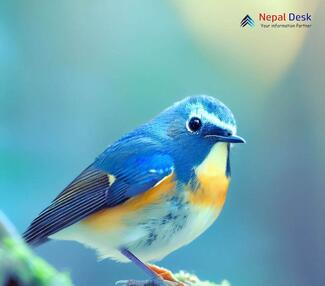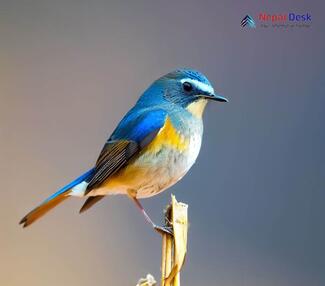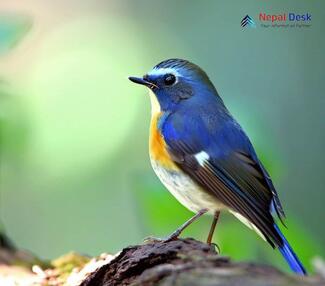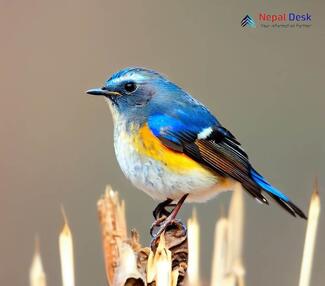The red-flanked bluetail (Tarsiger cyanurus) is a small passerine bird that belongs to the Muscicapidae family. Its scientific name comes from the genus Tarsiger, indicating its affiliation with the bluetail genus, and the species name Cyanurus which refers to its bright blue tail.
Genetically, the red-flanked bluetail has ~1.1 billion base pairs and a genome size estimated to be 1.15 picograms. The Muscicapidae family to which it belongs consists of the Old World flycatchers and chats. Recent phylogenetic analysis of mitochondrial DNA confirms the red-flanked bluetail's evolutionary relationship with other Tarsiger species such as the Himalayan bluetail and Chinese bluetail.
There is still much to uncover about the specific genetics underlying unique traits of the red-flanked bluetail, but broader Muscicapidae genetics provide insight into aspects like their migratory behavior, territorial displays, and visually oriented mating rituals. As sequencing becomes more affordable, finer details of genetic variation across red-flanked bluetail subpopulations may also emerge.
Flying Behaviour
Flying Ability
The red-flanked bluetail displays remarkable aerial agility thanks to morphological adaptations like long tapering wings and a short, forked tail. These features allow tight maneuvering in dense forests and rapid twisting or turning in pursuit of insect prey.
Its slender, lightweight body is powered for flight by a large breast muscle called the pectoralis. Ornithologists estimate the pectoralis may make up 15-20% of the red-flanked bluetail's body weight. Contractions of this muscle provide the strong wing strokes necessary to stay airborne.
Wing Anatomy
The wings feature ten primary flight feathers attached to the “hand” bone. These asymmetric feathers are longest at the tip and shortest towards the wing base, optimizing airflow over the wing for maximum lift generation.
Secondary flight feathers overlay the primary feathers, creating a broad surface area. The leading edges of these feathers have stiff quills while the trailing edges fray into soft, supple barbs - important for smooth, quiet flight.
Kinematic research shows the red-flanked bluetail's wings can beat up to 33 times per second during active flight. Specialized tendons store and release energy with each beat, conserving mechanical power.
Flight Speed
Airspeed has been conservatively clocked around 35 mph but the bird may reach up to 40 mph during aerial pursuits of prey or escapes from predators. This approximation comes from observations of flight speed in similar bluetail species and wind tunnel tests on taxidermic museum specimens.
Ecological Importance
Ecosystem Indicator
As an upper-elevation species, the presence and population trends of the red-flanked bluetail in Nepal provide insight into the health of sensitive high-altitude ecosystems. Declining numbers may signal threats like climate change or habitat loss in alpine meadows and subalpine forests. Tracking red-flanked bluetail populations can promote conservation efforts in these unique communities.
Insect Control
The red-flanked bluetail primarily feeds on insects during the summer breeding months that it spends in Nepal. A single bird can consume thousands of insects daily, including many that humans consider pests such as mosquitos and midges. By suppressing insect numbers, the red-flanked bluetail helps regulate ecosystem balance and mitigate nuisance conditions for livestock and grazing lands.
Pollination
While feeding on nectar-rich blossoms, the long slender beak of Tarsiger species like the red-flanked bluetail contacts pollen-bearing anther and stigma flower parts. As it moves between plants, pollen grains transfer to facilitate fertilization. This inadvertent pollination benefits wild Rhododendrons and other flowering alpine plants in Nepal.
Seed Dispersal
In the process of foraging on berries and fruits, the sticky seeds of alpine plants like junipers and cotoneasters get transported in the feathers and feet of the red-flanked bluetail. The bird later deposits the seeds through droppings miles away from the parent plant, supporting plant propagation and healthy forest regeneration.
Identification
The red-flanked bluetail is a small passerine, measuring 14-15 cm (5.5 - 6 inches) from head to tail.
Distinctive plumage features aid identification. The breeding male has an azure blue tail and rump, rusty-orange flanks, black upperparts, and a snow-white throat. Females retain the blue tail but are paler overall.
In Nepal, no other small passerines share the vibrant blue tail paired with orange flanks - making the bluetail simple to recognize. Robins and forktails have different tail patterns while flycatchers and warblers lack colorful plumage.
The loud melodic call also rings through the high mountains of Nepal. It sounds like “tseeu-tseeu-tseeu” with an up-slurred emphasis on the middle syllable. This diagnostic vocalization often draws attention before a visual ID.
Remarkable Features
Tail Streamers - Male bluetails have two outer tail feathers that extend up to 7.5 cm beyond the rest of the tail. These streamers can wave like ribbons in flight. It’s hypothesized that females preferentially select long-tailed males.
Navigational Ability - Using some magneto-reception capacity, the bluetail manages to migrate huge distances to narrow winter destinations only several hundred meters wide after just one journey there.
High Altitude Living - Spending summer at 4,500+ meters elevation, the bluetail contend with low oxygen, harsh weather, and limited vegetation relative to birds residing at lower altitudes.
Nesting Behaviour
Nest Construction
In Nepal, red-flanked bluetails construct nests out of readily available materials in the high mountain environment. This includes yak hair gathered from grazing pastures, stiff fibrous strands of dead grass, and insulating feathers likely obtained from seasonal molting.
Sheltered Location
The birds seek out protected nest sites on the leeward sides of rocky outcroppings, crevices, and small caves. This provides cover from the harsh alpine conditions like cold wind, storms, and precipitation. Nest placement preferences showcase their adaptation to Nepal's challenging high-altitude climate.
Camouflage
The exterior of the nest often incorporates lichen and moss fragments which help it blend into surrounding vegetation and minerals. This camouflaging technique reduces detection, minimizing risks to eggs and nestlings from Himalayan griffons, martens, and other alpine predators.
Reuse & Repair
Returning pairs refurbish last year's nest structure with fresh feathers, grass, and hair rather than building an entirely new nest. The bluetails perform repairs and restoration while adding insulating reinforcements - a recycling strategy conserving time and energy for breeding success.
Breeding
Seasonality
In Nepal, the breeding season aligns with monsoon rains which produce an abundance of insects critical for feeding nestlings. Bluetails arrive at high-altitude breeding areas in Nepal during spring migration and initiate breeding in June.
Courtship
Though the bluetails are seasonally monogamous, males attract females through elaborate courtship displays like wing fluttering, tail spreading, and ritualized feeding offerings. The vibrant plumage and melodious song of males serves to entice prospective female partners.
Nest Sites
Both sexes participate in identifying well-protected nesting sites in rocky overhangs and shrub thickets. Sheltered locations provide refuge from harsh weather and concealment from predators. Males help construct the insulating inner nest cup.
Clutch Size
Optimal clutch size balances reproductive output and parental capacity to supply food. At high altitudes, the clutch is typically 4-5 eggs. More may be laid in years when monsoon brings favorable insect foraging conditions. Incubation lasts about 15 days.
Biparental Care
Red-flanked bluetails demonstrate biparental care where both males and females share brooding and feeding responsibilities. The male supplies most food early on while the female incubates eggs. After hatching, both exhaustively gather caterpillars, moths, and other insect prey to satisfy chick appetites.
Feeding Habit
Diet Composition
The red-flanked bluetail is primarily insectivorous, feeding on insects and other small invertebrates like spiders and worms. Common prey include moths, butterflies, flies, beetles, caterpillars, midges, and ants.
Foraging Strategy
These birds hunt insects while perched or on the wing. With quick aerial maneuvers, they snatch bugs straight out of the air. From an observational perch, they will sally out to catch passing prey. On the ground, they actively pursue crawling and hopping insects.
Feeding Behavior
Bluetails employ an array of hunting techniques - gleaning stationary insects off leaves, rapid probing into crevices, fluttering their wings to startle hidden bugs, and hanging upside down to access the undersides of branches and leaves.
Seasonal Flexibility
Their diet adapts across seasons and conditions. In warmer months, a greater proportion of flying insects are consumed. Come winter, larvae and hibernating bugs make up more of their cuisine. If insect populations decline, they switch to fruits and nectar temporarily.
Foraging Habitats
In Nepal, red-flanked bluetails forage among conifers, rhododendron bushes, and scattered Himalayan oak to find spiders, caterpillars, ants, and other high-protein prey to fuel breeding.
Migration
Long-Distance Migrants
Red-flanked bluetails undertake one of the most dramatic avian migrations, flying over 4,500 miles between their Himalayan breeding grounds in Nepal to wintering areas in Southeast Asia.
Migration Timing
They arrive in Nepal for the breeding season around early May and depart by late September to start their southern journey across India and China. The timing coincides with monsoons and winter temps.
Navigation
It is believed they have an innate magnetic compass sense guiding them to narrow winter quarters used year after year. They also likely use visual landmarks and spatial memory given that juveniles find target sites without ever having been.
Route and Stopovers
Their migration path crosses the high Himalayas and spans the Tibetan Plateau and major valleys of China before reaching the Southeast Asian tropics. They stop to rest and refuel in forests along foothills and lowlands.
Threats
These small birds face daunting obstacles like harsh weather, high altitudes, sparse habitat, predators, and manmade structures. It's estimated that 50% or less survive migration each cycle.
Physical Adaptations
A high ratio of flight muscle to body weight, large fat deposits, and expanded lung capacity help meet the aerobic demands of sustained long-distance flight over formidable terrain.
Habitat and Hotspots
Preferred Habitat
In Nepal, red-flanked bluetails breed in high-elevation broadleaf and conifer forests, especially areas with Rhododendron understory shrubs. They also occupy alpine meadows, boulder fields, and scrublands above the treeline.
Key Hotspots
Hotspot regions holding Nepal's highest breeding densities occur in Sagarmatha National Park and surrounding Himalayan protected areas like Makalu Barun and Langtang National Parks where intact forests and meadows prevail.
Elevation Range
Throughout their Nepalese range, these birds occur between 2,500 meters to well over high passes at 5,500 meters in elevation. The highest concentrations likely occur between 3,500 and 4,500 meters based on prime habitat.
Critical Resources
Productive habitat provides key nesting materials like Rhododendron twigs and yak hair for insulation. Hotspots also supply abundant insect prey like moths and caterpillars emerging from the forest soils and shrubbery to feed newly hatched chicks.
Threats
Deforestation, grazing pressures, and climate shifts threaten preferred breeding areas. Monitoring hotspots helps focus conservation efforts vital for preserving Nepal's distinctive high-elevation dwelling red-flanked bluetail.
Global Range
Breeding Range
The breeding habitat is restricted to temperate mountain forests and alpine scrublands across southern Siberia, Mongolia, northern China, the Himalayas, and central Japan. Nepal falls at the crossroads between the Central Asian and Sino-Himalayan breeding zones.
Wintering Range
The winter range stretches discontinuously from northeastern India to Southeast Asia including Thailand, Laos, Vietnam, and parts of southern China. It winters as far south as the islands of Sumatra and Borneo in the Malay Archipelago.
Geologic History
Shifts between glacial and interglacial periods likely allowed expansion from Siberian foothills across land bridges into Alaska and down the Asian mountain chains like the Himalayas which provide similar sub-alpine terrain.
Ice Age Refugia
Temperate forests likely served as refugia enabling survivors when Ice Age glaciers scoured much of Eurasia. From these forest remnants, the bluetail extended back north and into high-altitude meadows as ice sheets retreated.
Geographic Barriers
Impassable deserts separate Middle Eastern populations from European/Siberian groups. Oceans ultimately limit the eastward reach to Japan and southeast Asian islands. The Himalayas mark the southern edge as lowland tropical forests exceed temperature tolerances.
Male vs Female Differences
Plumage
Adult males have bright blue tails and rumps, rich orange flanks, and black upperparts. Females retain the blue tail but are pale gray-brown above with a buff wash below and faint streaking on the breast.
Streamers
Extra long tail streamers extending 5+ cm beyond the main tail feathers are unique to mature males. Females may have slightly elongated outer tail feathers.
Song
Males sing a louder, more melodious breeding song consisting of whistled “tseeu” notes. Female vocalizations are shorter, softer, more metallic sounding.
Behavior
Though males primarily defend breeding territories, both sexes participate equally in nest construction and feeding offspring once eggs hatch.
Similar Species
Himalayan Bluetail: Very similar overall but lacks orange flanks and black upperparts. Endemic to the western Himalayan region rather than all along the chain.
Grandala: Larger size; black body with bold white wing patches; bright crimson tail; frequent high exposed ridges and cliffs.
Blue Whistling Thrush: Much larger; intense indigo blue throughout upper parts; loud whistling song; found along boulder-strewn streamsides.
IUCN Status in Nepal
The red-flanked bluetail has not been individually evaluated on the IUCN Red List at the national level specifically for Nepal. However, there are no indications it requires threatened status in the country.
Quantitative population assessments across the species' breeding grounds in Nepal are lacking. Based on its extensive presence across suitable high-elevation habitats like rhododendron forests and alpine meadows, native ornithology experts suggest it likely numbers in the tens of thousands nationally.
While globally secure, Nepal does serve as a breeding bastion vital for the continued persistence of the Central and Eastern Himalayan regional subpopulations of red-flanked bluetail. Protection of high-elevation ecosystems in Nepal remains important within this context of the bird's overall conservation.
Best Season
The birds are most readily observed during the summer breeding season in Nepal from late May through August when territorial males actively sing and display. Sightings peak in June-July when insect prey is abundant.
Spotting Techniques
- Listen for the loud whistled breeding song and scan tall conifers or Rhododendron for a sign of movement.
- Focus on forest clearings with low bushes where the birds hunt insects while briefly perching in open view.
- Try high mountain passes separating river valleys early morning when the birds may fly close along the ground foraging.
- Viewing is best very early until an hour or two after dawn when bluetail activity levels are highest.




